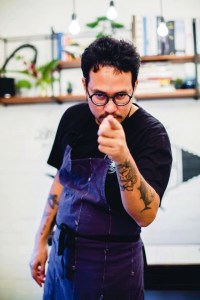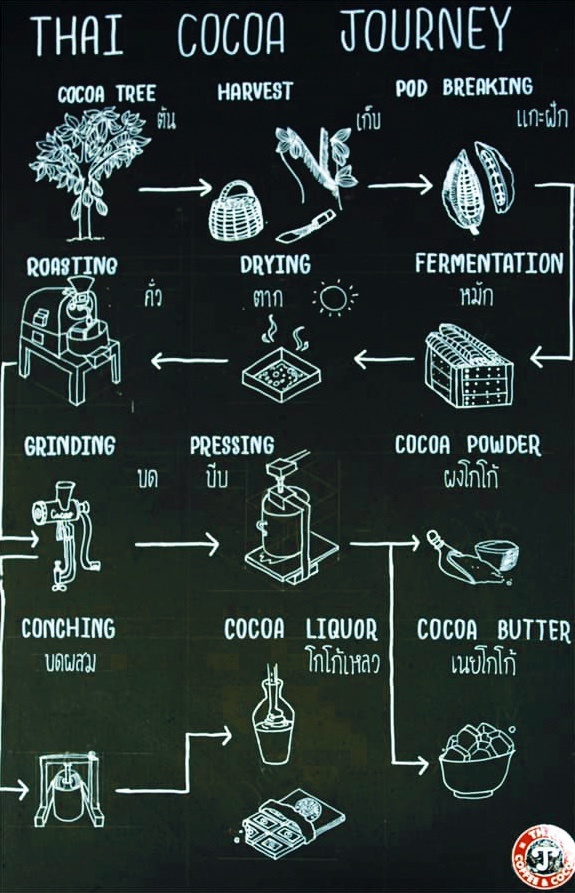Chef Black Talks Thai Cacao
Based on a Utopic Food video project by Arlei Lima, Chef Black Hatena of Blackitch, Chiang Mai presents a brief backstory, diversity, relevance and use of cacao grown and produced in Thailand. Chef Black has a strong work experience focusing on fermentation and other sustainable practices around food. He has also been actively engaged in the exchange of knowledge with local farmers and traditional communities especially up in the north. His research on Thai cacao and its sub-products from each stage of the complex cacao bean processing cycle introduces some fresh ideas.
Tattooed on his arm, Chef Black runs his restaurant according to these six philosophies: artisan, creativity, umami, balance, fermentation and localisation. His kitchen controls and manages zero food waste.


Thai Cacao discussion with Chef Black Hatena of Blackitch restaurant, Chiang Mai
Based on a Utopic Food video project by Arlei Lima, Chef Black Hatena of Blackitch, Chiang Mai presents a brief backstory, diversity, relevance and use of cacao grown and produced in Thailand. Chef Black has a strong work experience focusing on fermentation and other sustainable practices around food. He has also been actively engaged in the exchange of knowledge with local farmers and traditional communities especially up in the north. His research on Thai cacao and its sub-products from each stage of the complex cacao bean processing cycle introduces some fresh ideas.
Tattooed on his arm, Chef Black runs his restaurant according to these six philosophies: artisan, creativity, umami, balance, fermentation and localisation. His kitchen controls and manages zero food waste.


He first heard about cacao from his father who worked with coffee and cacao 40 years ago. There are many coffee shops in Thailand for both coffee and non-coffee drinkers. His study suggests that 50 per cent of their income comes from coffee sales while the other 50 per cent comes from chocolate or cocoa. But the problem is, most local dry and high-quality cacao is exported to other countries rather than consumed domestically while the actual cacao used in Thailand is imported.
This inspired Chef Black to do an in-depth exploration on Thai cacao. First, he travels to visit the local cacao farmers in different locations throughout the country. Cacao trees can be grown literally anywhere in Thailand. At Thai Coffee and Cocoa in Lampang, Northern Thailand, for instance, they use cacao pods from Nakhon Si Thammarat in the south. Mr Pathom, the owner, started the cacao primary which sells saplings to other farmers in Northern Thailand such as in Lamphun and Chaing Mai. The oldest bean variety originates from Chumphon which is blended with other varieties to create a stronger tasting profile.
One of the cacao farms that he visited was Mr Wichai’s in Chiang Mai. A friend of Mr Wichai initially sent about 300 plants to him to grow two years ago. Now, the farm has expanded to over 5,000 plants. Leftovers from every process such as the juice from fermentation and the shells from roasting can be reused and improve the farmers’ quality of life. Cacao vinegar mixed with rose apple juice is good for digestive system. Juice from the first fermentation is sweet due to the yeast in the air that soaks through the cacao beans and intakes the sugar in the container.


For the natural fermentation, more than 50kg of fresh cacao is pressed inside one large box. An ideal fermenting process does not let in lots of air. A ton of cacao yields 30 litres of liquid which can produce alcohol and cider-like vinegar similar to kombucha. This is only the beginning of an experiment, which can lead to many more flavourful and favourable possibilities.






Leave a Reply